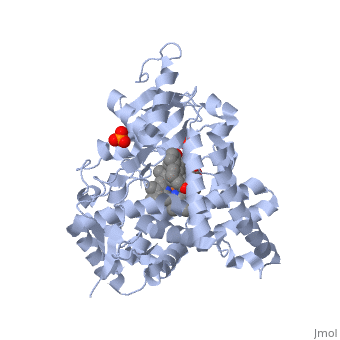Sandbox Reserved 382
From Proteopedia
| Line 9: | Line 9: | ||
This enzyme helps produce this female sex hromone that helps to fuel the growth of hormone receptor-positive breast cancer. | This enzyme helps produce this female sex hromone that helps to fuel the growth of hormone receptor-positive breast cancer. | ||
== Aromatase Inhibitors == | == Aromatase Inhibitors == | ||
| - | Inhibitors of Aromatase stop the estrogen production in post-menopausal women. This action is done by blocking the Aromatase enzyme by turning the hormone, androgen, into small amounts of estrogen. <ref> "Aromatase Inhibitors" [http://www.breastcancer.org/treatment/hormonal/aromatase_inhibitors/] < | + | Inhibitors of Aromatase stop the estrogen production in post-menopausal women. This action is done by blocking the Aromatase enzyme by turning the hormone, androgen, into small amounts of estrogen. <ref> "Aromatase Inhibitors" [http://www.breastcancer.org/treatment/hormonal/aromatase_inhibitors/] </ref> |
There are three Aromatase Inhibitors that are often used in the treatment of breast cancer: | There are three Aromatase Inhibitors that are often used in the treatment of breast cancer: | ||
*Arimidex (Anastrozole) | *Arimidex (Anastrozole) | ||
| Line 19: | Line 19: | ||
Aromatase Dificiency is rare in humans, however, if aromatase is nonfunctional due to a mutation estrogen synthesis cannot occur. Affected females are diagnoses at birth because of the obvious characteristics of pseudohermaphroditism. During the childhood of these girls, delayed bone maturation can occur along with cystic ovaries. However, affected males are diagnosed later in life because there are not obvious birth defects. Clincal symptoms such as a tall physique, delayed bone maturation and epiphyseal closure, bone pain, and excess adiposy. <ref> Jones, M., Boon, W., McInnes, K. "Recognizing Rare Disorders: Aromatase Deficiency". [http://www.ncbi.nlm.nih.gov/pubmed/17452968] </ref> | Aromatase Dificiency is rare in humans, however, if aromatase is nonfunctional due to a mutation estrogen synthesis cannot occur. Affected females are diagnoses at birth because of the obvious characteristics of pseudohermaphroditism. During the childhood of these girls, delayed bone maturation can occur along with cystic ovaries. However, affected males are diagnosed later in life because there are not obvious birth defects. Clincal symptoms such as a tall physique, delayed bone maturation and epiphyseal closure, bone pain, and excess adiposy. <ref> Jones, M., Boon, W., McInnes, K. "Recognizing Rare Disorders: Aromatase Deficiency". [http://www.ncbi.nlm.nih.gov/pubmed/17452968] </ref> | ||
*'''Aromatase Excess Syndrome''' | *'''Aromatase Excess Syndrome''' | ||
| - | Research shows a rare disorder caused by excessive aromatase activity that can cause familial gynecomastia and feminization of both sexes. This can be inherited by an autosomal dominant manner, affected females and males differently. Females with this disorder showed signs of isosexual precocity and/or macromastia. Males showed characteristics of heterosexual precocity and/or gynecomastia. <ref> Stratakis, C., Vottero, A. "The Aromatase Excess Syndrome is Associated with Feminization of Bost Sexes and Autosomal Dominant Transmission of Aberrant p450 Aromatase Gene Transcription. [http://www.ncbi.nlm.nih.gov/pubmed/9543166] < | + | Research shows a rare disorder caused by excessive aromatase activity that can cause familial gynecomastia and feminization of both sexes. This can be inherited by an autosomal dominant manner, affected females and males differently. Females with this disorder showed signs of isosexual precocity and/or macromastia. Males showed characteristics of heterosexual precocity and/or gynecomastia. <ref> Stratakis, C., Vottero, A. "The Aromatase Excess Syndrome is Associated with Feminization of Bost Sexes and Autosomal Dominant Transmission of Aberrant p450 Aromatase Gene Transcription. [http://www.ncbi.nlm.nih.gov/pubmed/9543166] </ref> |
== References == | == References == | ||
| - | < | + | </references> |
Revision as of 18:22, 28 November 2011
| This Sandbox is Reserved from September 14, 2021, through May 31, 2022, for use in the class Introduction to Biochemistry taught by User:John Means at the University of Rio Grande, Rio Grande, OH, USA. This reservation includes 5 reserved sandboxes (Sandbox Reserved 1590 through Sandbox Reserved 1594). |
To get started:
More help: Help:Editing. For an example of a student Proteopedia page, please see Photosystem II, Tetanospasmin, or Guanine riboswitch. |
Contents |
Aromatase
|
Introduction
Aromatase belongs to the cytochrome p450 family. During aromatization reactions, Aromatase forms an electron-transfer complex with its partner, NADPH-cytochrome p450 reductase. Aromatase is an enzyme that aids in the biosynthesis of estrogens. The aromatase enzyme can be found in many tissues in the body such as the brain, placenta, adipose tissue, blood vessels, gonads, endometrium, skin, and bone.
Function
This enzyme helps produce this female sex hromone that helps to fuel the growth of hormone receptor-positive breast cancer.
Aromatase Inhibitors
Inhibitors of Aromatase stop the estrogen production in post-menopausal women. This action is done by blocking the Aromatase enzyme by turning the hormone, androgen, into small amounts of estrogen. [1] There are three Aromatase Inhibitors that are often used in the treatment of breast cancer:
- Arimidex (Anastrozole)
- Aromasin (Exemestane)
- Femara (Letrozole)
Aromatase Inhibitors are unable to stop ovaries from producing estrogen, therefore, these inhibitors only work in post-menopausal women.
Disorders
- Aromatase Enzyme Deficiency
Aromatase Dificiency is rare in humans, however, if aromatase is nonfunctional due to a mutation estrogen synthesis cannot occur. Affected females are diagnoses at birth because of the obvious characteristics of pseudohermaphroditism. During the childhood of these girls, delayed bone maturation can occur along with cystic ovaries. However, affected males are diagnosed later in life because there are not obvious birth defects. Clincal symptoms such as a tall physique, delayed bone maturation and epiphyseal closure, bone pain, and excess adiposy. [2]
- Aromatase Excess Syndrome
Research shows a rare disorder caused by excessive aromatase activity that can cause familial gynecomastia and feminization of both sexes. This can be inherited by an autosomal dominant manner, affected females and males differently. Females with this disorder showed signs of isosexual precocity and/or macromastia. Males showed characteristics of heterosexual precocity and/or gynecomastia. [3]
References
</references>

